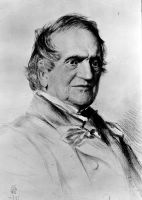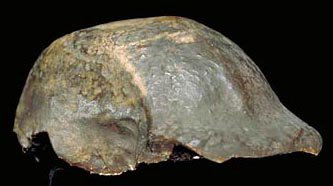After an extended break, the Palaeoblog is officially closing up shop.
When it started up almost 10 years ago it was a great way to get palaeo-related news out to people who would otherwise have a hard time finding it. Blogs like this have now been largely superseded by other forms of social media, so I have no doubt that you've all got better ways to stay informed. Thanks for all the support over the years!
Monday, August 12, 2013
Wednesday, May 29, 2013
Albertadromeus syntarus, New Ornithopod from Alberta
New data on the diversity and abundance of smallbodied ornithopods (Dinosauria, Ornithischia) from the Belly River Group (Campanian) of Alberta. 2013. Brown, C.M., et al. Journal of Vert. Paleo. 33: 495-520.
Wednesday, May 08, 2013
Acrotholus audeti, a New Pachycephalosaur from Alberta
The oldest North American pachycephalosaurid and the hidden diversity of small-bodied ornithischian dinosaurs. 2013. D.C. Evans, et al. Nature Communications
Tuesday, May 07, 2013
Ray Harryhausen 1920-2013

Ray Harryhausen passed away today. No doubt his spirit is roaming a jungle somewhere "way west of Sumatra" with Willis, Merian, Ernest, Ruth, and Carl Denham looking for giant gorillas!
The Ray & Diana Harryhausen Foundation
Wednesday, April 17, 2013
Premiered This Day (1981): Caveman
Directed by Carl Gottlieb and starring Ringo Starr, this film is probably best known for introducing Starr to his future wife, Barbara Bach. Famed Animator Jim Danforth oversaw the creation of the dinosaurs.
A more interesting film with overtones of The Creature From The Black Lagoon (0:57) is Island of the Fish Men, also starring Bach.
A more interesting film with overtones of The Creature From The Black Lagoon (0:57) is Island of the Fish Men, also starring Bach.
Tuesday, April 16, 2013
Died This Day: Comte Georges-Louis Leclerc de Buffon
Buffon (Sept. 7, 1707 – April 16, 1788) was a French naturalist, who formulated a crude theory of evolution and was the first to suggest that the earth might  be older than suggested by the Bible.
be older than suggested by the Bible.
In 1739 he was appointed keeper of the Jardin du Roi, a post he occupied until his death. There he worked on a comprehensive work on natural history, for which he is remembered, Histoire naturelle, générale et particulière. He began this work in 1749, and it dominated the rest of his life. It would eventually run to 44 volumes, including quadrupeds, birds, reptiles and minerals.
He proposed (1778) that the Earth was hot at its creation and, from the rate of cooling, calculated its age to be 75,000 years, with life emerging some 40,000 years ago.
From Today In Science History. Stamp from HERE.
More info on Buffon from UC-Berkeley.
 be older than suggested by the Bible.
be older than suggested by the Bible. In 1739 he was appointed keeper of the Jardin du Roi, a post he occupied until his death. There he worked on a comprehensive work on natural history, for which he is remembered, Histoire naturelle, générale et particulière. He began this work in 1749, and it dominated the rest of his life. It would eventually run to 44 volumes, including quadrupeds, birds, reptiles and minerals.
He proposed (1778) that the Earth was hot at its creation and, from the rate of cooling, calculated its age to be 75,000 years, with life emerging some 40,000 years ago.
From Today In Science History. Stamp from HERE.
More info on Buffon from UC-Berkeley.
Died This Day: Rosalind Franklin
Rosalind Franklin (July 25, 1920 - Apr. 16, 1958) was an English scientist who contributed to the discovery of the molecular structure of deoxyribonucleic acid (DNA), a constituent of chromosomes that serves to encode genetic information. Beginning in 1951, she made careful X-ray diffraction photographs of DNA, leading her to suspect the helical form of the molecule, at least under the conditions she had used.
When Watson saw her photographs, he had confirmation of the double-helix form that he and Crick then published. She never received the recognition she deserved for her independent work, but had died of cancer four years before the Nobel Prize was awarded to Crick and Watson.
From Today In Science History
When Watson saw her photographs, he had confirmation of the double-helix form that he and Crick then published. She never received the recognition she deserved for her independent work, but had died of cancer four years before the Nobel Prize was awarded to Crick and Watson.
From Today In Science History
Monday, April 15, 2013
Premiered This Day: Women of The Prehistoric Planet
Written and directed by Arthur C. Pierce, and starring the perennial C-list actor John Agar (who had his own Prehistoric Theme Park!), this is just about as bad as it gets.
Tuesday, April 02, 2013
Published This Day: DNA Double Helix
From Today in Science History:

On this day in 1953, the journal Nature published a paper from Francis Crick and James Watson, titled Molecular Structure of Nucleic Acids: A Structure for Deoxyribose Nucleic Acid, in which they described a double helix structure for DNA.
Download the paper from Nature HERE.

On this day in 1953, the journal Nature published a paper from Francis Crick and James Watson, titled Molecular Structure of Nucleic Acids: A Structure for Deoxyribose Nucleic Acid, in which they described a double helix structure for DNA.
Download the paper from Nature HERE.
Saturday, March 30, 2013
Geological Time Scale First Proposed (1759)
In 1759, Italian geologist Giovanni Arduino (1714-1795) dated a letter to Professor A.Vallisneri the younger, in which Arduino proposed a classification of Earth's surface rocks according to four brackets of successively younger orders: Primary, Secondary, Tertiary and Quaternary. These are the four geological eras used today. The volcanic rocks without fossils which he saw in the Atesine Alps that formed the cores of large mountains he called Primary. Overlying them, the fossil rich rocks of limestone and clay that were found on the prealpine flanks of the mountains he called Secondary. The less consolidated fossil-bearing rocks of the subalpine foothills, he named Tertiary, and the alluvial rock deposits in the plains were the Quaternary. link
Friday, March 29, 2013
Premiered This Day: Gorgo
Gorgo premiered on this day in 1961. Directed by Eugène Lourié from a script by John Loring and Daniel Hyat, it featured a man in a rubber suit ala Toho’s Godzilla. More ignored than maligned, it holds up very well & is a well worth watching. Plus, it's newly available on Blu-Ray.
Over at Atomic Surgery the good doctors present a double bill to commemorate the day: a story by Steve Ditko from Gorgo #15 and a Gorgo filmbook from Famous Monsters of Filmland #50.
Over at Atomic Surgery the good doctors present a double bill to commemorate the day: a story by Steve Ditko from Gorgo #15 and a Gorgo filmbook from Famous Monsters of Filmland #50.
Monday, March 25, 2013
The End Triassic Extinction
Zircon U-Pb geochronology links the end-Triassic extinction with the Central Atlantic Magmatic Province. Blackburn, T.J., et al., Science, published on-line 21 March 2013
Now researchers at MIT, Columbia University and elsewhere have determined that these eruptions occurred precisely when the extinction began, providing strong evidence that volcanic activity did indeed trigger the end-Triassic extinction. link.
More than 200 million years ago, a massive extinction decimated 76 percent of marine and terrestrial species, marking the end of the Triassic period and the onset of the Jurassic. This devastating event cleared the way for dinosaurs to dominate Earth for the next 135 million years, taking over ecological niches formerly occupied by other marine and terrestrial species.It’s not entirely clear what caused the end-Triassic extinction, although most scientists agree on a likely scenario: Over a relatively short period of time, massive volcanic eruptions from a large region known as the Central Atlantic Magmatic Province (CAMP) spewed forth huge amounts of lava and gas, including carbon dioxide, sulfur and methane. This sudden release of gases into the atmosphere may have created intense global warming and acidification of the oceans that ultimately killed off thousands of plant and animal species.
Now researchers at MIT, Columbia University and elsewhere have determined that these eruptions occurred precisely when the extinction began, providing strong evidence that volcanic activity did indeed trigger the end-Triassic extinction. link.
Tuesday, February 26, 2013
Scrappy Little Jaw
The Ottawa, ON, based band <><>>>>> (aka The Band Whose Name is A Symbol, aka TBWNIS) will shortly be releasing their new vinyl-only LP, Scrappy Little Jaw. Yes, that scrappy little jaw on the cover is the holotype of Gryphoceratops.
If you want to pick up a copy of this limited edition beauty contact John at Birdman Sound.
If you want to pick up a copy of this limited edition beauty contact John at Birdman Sound.
Monday, February 25, 2013
The Brainless Origin of The Head
The bilaterian head patterning gene six3/6 controls aboral domain development in a cnidarian. 2013. Sinigaglia, C., et al. PLoS Biology 10.1371/journal.pbio.1001488.
In a simple, brainless sea anemone, the same genes that control head development in higher animals regulate the development of the front end of the swimming larvae. link
Author Summary [edit]: The evolutionary origin of head development is a fundamental question for understanding the evolution of animal body plans. Bilaterally symmetrical animals (Bilaterians) have an anterior-posterior (head-to-tail) axis, whose anterior end is usually characterized by a head and a brain.
Bilaterians evolved from an ancestor shared with cnidarians (corals, sea anemones, jellyfish), but brain-like structures are absent in cnidarians, although they have an obvious oral-aboral axis. Cnidarian larvae move with the aboral pole forward, but as adult polyps this pole is anchored to the ground, while the oral end is used for feeding. It is unclear whether one of the termini of cnidarians corresponds to the bilaterian head-forming region.
We show here that in the sea anemone Nematostella vectensis genes regulating bilaterian head development are expressed at the larval aboral pole and that a key anterior developmental gene, six3/6, controls the development of the aboral pole. These findings support the hypothesis that the anterior, head-forming, region of bilaterians and the aboral region of cnidarians derived from the same domain of their last common ancestor and are therefore homologues.
In a simple, brainless sea anemone, the same genes that control head development in higher animals regulate the development of the front end of the swimming larvae. link
Author Summary [edit]: The evolutionary origin of head development is a fundamental question for understanding the evolution of animal body plans. Bilaterally symmetrical animals (Bilaterians) have an anterior-posterior (head-to-tail) axis, whose anterior end is usually characterized by a head and a brain.
Bilaterians evolved from an ancestor shared with cnidarians (corals, sea anemones, jellyfish), but brain-like structures are absent in cnidarians, although they have an obvious oral-aboral axis. Cnidarian larvae move with the aboral pole forward, but as adult polyps this pole is anchored to the ground, while the oral end is used for feeding. It is unclear whether one of the termini of cnidarians corresponds to the bilaterian head-forming region.
We show here that in the sea anemone Nematostella vectensis genes regulating bilaterian head development are expressed at the larval aboral pole and that a key anterior developmental gene, six3/6, controls the development of the aboral pole. These findings support the hypothesis that the anterior, head-forming, region of bilaterians and the aboral region of cnidarians derived from the same domain of their last common ancestor and are therefore homologues.
Thursday, February 21, 2013
Bads News on Jobs for Recent Ph.D.s
Read the article at The Atlantic: The Ph.D Bust: America's Awful Market for Young Scientists—in 7 Charts
Tuesday, February 12, 2013
Born This Day: Barnum Brown
From the AMNH bio:
The greatest dinosaur hunter of the twentieth century was Barnum Brown, who began his career at the American Museum of Natural History in 1897 as an assistant to Henry Fairfield Osborn. Brown traveled all over the world collecting dinosaurs and fossil mammals. Some consider him to be the last of the great dinosaur hunters.
Brown was always impeccably dressed, often wearing a tie and topcoat even in the field. He was a shrewd "horse trader" when it came to wheeling and dealing for fossil specimens. Many of Brown's greatest discoveries, including the first specimens of Tyrannosaurus rex ever found, are displayed in the Museum's Dinosaur Halls.
The greatest dinosaur hunter of the twentieth century was Barnum Brown, who began his career at the American Museum of Natural History in 1897 as an assistant to Henry Fairfield Osborn. Brown traveled all over the world collecting dinosaurs and fossil mammals. Some consider him to be the last of the great dinosaur hunters.
Brown was always impeccably dressed, often wearing a tie and topcoat even in the field. He was a shrewd "horse trader" when it came to wheeling and dealing for fossil specimens. Many of Brown's greatest discoveries, including the first specimens of Tyrannosaurus rex ever found, are displayed in the Museum's Dinosaur Halls.
Sunday, February 10, 2013
Published This Day: Steno Recognizes the Organic Origin of Fossils
From Today In Science History:
In 1667, a classic paleontological paper by Nicolaus Steno was published by the Royal Society, London. His topic, Head of a shark dissected, represented the first such scientific paper to recognise that fossils were the remains of creatures who had died and subsequently had become petrified. Controversy resulted as the same claim had been made in the time of the ancient Greeks, two millennia earlier.
In 1667, a classic paleontological paper by Nicolaus Steno was published by the Royal Society, London. His topic, Head of a shark dissected, represented the first such scientific paper to recognise that fossils were the remains of creatures who had died and subsequently had become petrified. Controversy resulted as the same claim had been made in the time of the ancient Greeks, two millennia earlier.
Saturday, February 09, 2013
Asteroid Did Kill The Dinosaurs
Time Scales of Critical Events Around the Cretaceous-Paleogene Boundary. 2013. P.R. Renne, et al. Science 339: 684-687.
Abstract: Mass extinctions manifest in Earth's geologic record were turning points in biotic evolution. We present 40Ar/39Ar data that establish synchrony between the Cretaceous-Paleogene boundary and associated mass extinctions with the Chicxulub bolide impact to within 32,000 years. Perturbation of the atmospheric carbon cycle at the boundary likely lasted less than 5000 years, exhibiting a recovery time scale two to three orders of magnitude shorter than that of the major ocean basins. Low-diversity mammalian fauna in the western Williston Basin persisted for as little as 20,000 years after the impact. The Chicxulub impact likely triggered a state shift of ecosystems already under near-critical stress.
Abstract: Mass extinctions manifest in Earth's geologic record were turning points in biotic evolution. We present 40Ar/39Ar data that establish synchrony between the Cretaceous-Paleogene boundary and associated mass extinctions with the Chicxulub bolide impact to within 32,000 years. Perturbation of the atmospheric carbon cycle at the boundary likely lasted less than 5000 years, exhibiting a recovery time scale two to three orders of magnitude shorter than that of the major ocean basins. Low-diversity mammalian fauna in the western Williston Basin persisted for as little as 20,000 years after the impact. The Chicxulub impact likely triggered a state shift of ecosystems already under near-critical stress.
Wednesday, January 30, 2013
Published This Day: Variation of Animals and Plants under Domestication by Darwin
From Today In Science History:
In 1868, Charles Darwin's book - Variation of Animals and Plants under Domestication - was published. He was 58. It is probably the second in importance of all his works. This was a follow-up work, written in response to criticisms that his theory of evolution was unsubstantiated. Darwin here supports his views via analysis of various aspects of plant and animal life, including an inventory of varieties and their physical and behavioral characteristics, and an investigation of the impact of a species' surrounding environment and the effect of both natural and forced changes in this environment.
- Variation of Animals and Plants under Domestication - was published. He was 58. It is probably the second in importance of all his works. This was a follow-up work, written in response to criticisms that his theory of evolution was unsubstantiated. Darwin here supports his views via analysis of various aspects of plant and animal life, including an inventory of varieties and their physical and behavioral characteristics, and an investigation of the impact of a species' surrounding environment and the effect of both natural and forced changes in this environment.
In 1868, Charles Darwin's book
 - Variation of Animals and Plants under Domestication - was published. He was 58. It is probably the second in importance of all his works. This was a follow-up work, written in response to criticisms that his theory of evolution was unsubstantiated. Darwin here supports his views via analysis of various aspects of plant and animal life, including an inventory of varieties and their physical and behavioral characteristics, and an investigation of the impact of a species' surrounding environment and the effect of both natural and forced changes in this environment.
- Variation of Animals and Plants under Domestication - was published. He was 58. It is probably the second in importance of all his works. This was a follow-up work, written in response to criticisms that his theory of evolution was unsubstantiated. Darwin here supports his views via analysis of various aspects of plant and animal life, including an inventory of varieties and their physical and behavioral characteristics, and an investigation of the impact of a species' surrounding environment and the effect of both natural and forced changes in this environment.
Monday, January 28, 2013
Born This Day: Eugene Dubois
Eugene Dubois (Jan. 28, 1858-Dec. 16, 1940) joined the Dutch Army as a medical officer, and used spare time from his medical duties to search for fossils, first in Sumatra and then in Java. He searched on the banks of the Solo River, with two assigned engineers and a crew of convict labourers to help him. In September 1890, his workers found a human, or human-like, fossil at Koedoeng Broeboes. This consisted of the right side of the chin of a lower jaw and three attached teeth. In August 1891 he found a primate molar tooth.
He searched on the banks of the Solo River, with two assigned engineers and a crew of convict labourers to help him. In September 1890, his workers found a human, or human-like, fossil at Koedoeng Broeboes. This consisted of the right side of the chin of a lower jaw and three attached teeth. In August 1891 he found a primate molar tooth.
Two months later and one meter away was found an intact skullcap, the fossil which would be known as Java Man. In August 1892, a third primate fossil, an almost complete left thigh bone, was found between 10 and 15 meters away from the skullcap.
meter away was found an intact skullcap, the fossil which would be known as Java Man. In August 1892, a third primate fossil, an almost complete left thigh bone, was found between 10 and 15 meters away from the skullcap.
In 1894 Dubois published a description of his fossils, naming them Pithecanthropus erectus (now Home erectus), describing it as neither ape nor human, but something intermediate. In 1895 he returned to Europe to promote the fossil and his interpretation. A few scientists enthusiastically endorsed Dubois' work, but most disagreed with his interpretation. Many scientists pointed out similarities between the Java Man skullcap and Neandertal fossils.
Around 1900 Dubois ceased to discuss Java Man, and hid the fossils in his home while he moved on to other research topics. geology and paleontology. It was not until 1923 that Dubois, under pressure from scientists, once again allowed access to the Java Man fossils. That and the discovery of similar fossils caused it to once again become a topic of debate.
 He searched on the banks of the Solo River, with two assigned engineers and a crew of convict labourers to help him. In September 1890, his workers found a human, or human-like, fossil at Koedoeng Broeboes. This consisted of the right side of the chin of a lower jaw and three attached teeth. In August 1891 he found a primate molar tooth.
He searched on the banks of the Solo River, with two assigned engineers and a crew of convict labourers to help him. In September 1890, his workers found a human, or human-like, fossil at Koedoeng Broeboes. This consisted of the right side of the chin of a lower jaw and three attached teeth. In August 1891 he found a primate molar tooth.Two months later and one
 meter away was found an intact skullcap, the fossil which would be known as Java Man. In August 1892, a third primate fossil, an almost complete left thigh bone, was found between 10 and 15 meters away from the skullcap.
meter away was found an intact skullcap, the fossil which would be known as Java Man. In August 1892, a third primate fossil, an almost complete left thigh bone, was found between 10 and 15 meters away from the skullcap.In 1894 Dubois published a description of his fossils, naming them Pithecanthropus erectus (now Home erectus), describing it as neither ape nor human, but something intermediate. In 1895 he returned to Europe to promote the fossil and his interpretation. A few scientists enthusiastically endorsed Dubois' work, but most disagreed with his interpretation. Many scientists pointed out similarities between the Java Man skullcap and Neandertal fossils.
Around 1900 Dubois ceased to discuss Java Man, and hid the fossils in his home while he moved on to other research topics. geology and paleontology. It was not until 1923 that Dubois, under pressure from scientists, once again allowed access to the Java Man fossils. That and the discovery of similar fossils caused it to once again become a topic of debate.
Sunday, January 27, 2013
The Good Old Days of Dinosaur Provincal Park
As I was sorting through some old photos (circa 2000) I set aside some taken not all that long ago when the field station in DPP was the center for some cool palaeo-research. Above is outcrop right beside the field station that shows the contact between the Dinosaur Park and Oldman formations. Can you spot it?
Remember the great pair of styracosaurs sculpted by Brian Cooley that stood guard at the field station entrance?
The arrow points to BB138 that produced the holotype of Coronosaurus brinkmani. That multi-year project was initiated by Dave Eberth and run primarily by Mike Getty as part of the RTMP's Field Experience Program.
During the years the Field Experience Program ran, Mike and others (including myself) hosted a Prep Program in the field station that prepared 1000's of fossils collected in BB138 and other sites in DPP. I think that's ace voluteer, Don Cretin, with his back to the camera.
The holotype of Albertaceratops nesmoi under preparation in the field station.
Remember the great pair of styracosaurs sculpted by Brian Cooley that stood guard at the field station entrance?
The arrow points to BB138 that produced the holotype of Coronosaurus brinkmani. That multi-year project was initiated by Dave Eberth and run primarily by Mike Getty as part of the RTMP's Field Experience Program.
During the years the Field Experience Program ran, Mike and others (including myself) hosted a Prep Program in the field station that prepared 1000's of fossils collected in BB138 and other sites in DPP. I think that's ace voluteer, Don Cretin, with his back to the camera.
The holotype of Albertaceratops nesmoi under preparation in the field station.
Died This Day: Adam Sedgwick
From Today In Science History:
Sedgwick (March 22, 1785 - January 27, 1873) was an English geologist who first applied the name Cambrian to the geologic period of time, now dated at 570 to 505 million years ago. In 1818 he became Woodwardian Professor of Geology at Cambridge, holding a chair that had been endowed ninety years before by the natural historian John Woodward.
to the geologic period of time, now dated at 570 to 505 million years ago. In 1818 he became Woodwardian Professor of Geology at Cambridge, holding a chair that had been endowed ninety years before by the natural historian John Woodward.
He lacked formal training in geology, but he quickly became an active researcher in geology and paleontology. Many years after Sedgwick's death, the geological museum at Cambridge was renamed the Sedgwick Museum of Geology in his honor. The museum is now part of the Department of Earth Sciences at Cambridge University
Sedgwick (March 22, 1785 - January 27, 1873) was an English geologist who first applied the name Cambrian
 to the geologic period of time, now dated at 570 to 505 million years ago. In 1818 he became Woodwardian Professor of Geology at Cambridge, holding a chair that had been endowed ninety years before by the natural historian John Woodward.
to the geologic period of time, now dated at 570 to 505 million years ago. In 1818 he became Woodwardian Professor of Geology at Cambridge, holding a chair that had been endowed ninety years before by the natural historian John Woodward.He lacked formal training in geology, but he quickly became an active researcher in geology and paleontology. Many years after Sedgwick's death, the geological museum at Cambridge was renamed the Sedgwick Museum of Geology in his honor. The museum is now part of the Department of Earth Sciences at Cambridge University
Saturday, January 26, 2013
Born This Day: Roy Chapman Andrews
From the American Museum of Natural History web site:
Adventurer, administrator, and Museum promoter — Andrews (Jan. 26, 1884 – March 11, 1960) spent his entire career at the American Museum of Natural History, where he rose through the ranks from departmental assistant, to expedition organizer, to Museum director.
He became world famous as leader of the Central Asiatic Expeditions, a series of expeditions to Mongolia that collected, among other things, dinosaur eggs. Although on these expeditions, Andrews himself found few fossils, and during his career he was not known as an influential scientist, he instead filled the role of promoter, creating immense excitement and successfully advancing the research and exhibition goals of the museum.
Learn about the Roy Chapman Andrews Society HERE.
Friday, January 25, 2013
Born This Day: Theodosius Dobzhansky
Dobzhansky (Jan.25, 1900–Dec. 18, 1975) is noted for being one of the architects of the modern Synthetic Theory of evolution. During the first 20 years of the 20th century, Darwin's theory of natural selection had fallen out of favor among scientists. Many thought it  insufficient to explain the origin of adaptations, while new discoveries of gene mutations seemed to them to be incompatible with Darwinian models of change.
insufficient to explain the origin of adaptations, while new discoveries of gene mutations seemed to them to be incompatible with Darwinian models of change.
But in 1937 Dobzhansky published his book, Genetics and the Origin of Species, that was the first systematic overview view encompassing organic diversity, variation in natural populations, selection, isolating mechanisms (a term he coined) and species as natural units.
Later, working with Sewall Wright, he went on to demonstrate how evolution can produce stability and equilibrium in populations rather than constant directional change. link. image.
 insufficient to explain the origin of adaptations, while new discoveries of gene mutations seemed to them to be incompatible with Darwinian models of change.
insufficient to explain the origin of adaptations, while new discoveries of gene mutations seemed to them to be incompatible with Darwinian models of change. But in 1937 Dobzhansky published his book, Genetics and the Origin of Species, that was the first systematic overview view encompassing organic diversity, variation in natural populations, selection, isolating mechanisms (a term he coined) and species as natural units.
Later, working with Sewall Wright, he went on to demonstrate how evolution can produce stability and equilibrium in populations rather than constant directional change. link. image.
Tuesday, January 15, 2013
Sheep Taphonomy
Photo and caption by Johannes Bojesen
The sheep had drowned while trying to cross a small canal in the meadow-swamp 'Tøndermasken' in southern Jylland in Denmark. Birds had eaten every part above the surface and everything under was left totally untouched. Photo location: Tøndermarsken, Tønder, Denmark.From the 2012 National Geographic Photo Contest
Abstracts due for Vertebrate Paleontology session at North-Central GSA, 2013
You're invited to present at the GSA North-Central Section 47th Annual Meeting in Kalamazoo, Michigan, 2–3 May 2013. Evan Scott (ees20 at case dot edu.) and I (mryan at cmnh dot org) will be co-convening session T22, Topics in Vertebrate Paleontology. Talks on any aspect of post-Paleozoic vertebrate paleontology are appropriate.
We especially encourage presentations by students.
Abstract deadline is Feb. 5, 2013.
More information is available HERE
We especially encourage presentations by students.
Abstract deadline is Feb. 5, 2013.
More information is available HERE
Sunday, January 13, 2013
Thursday, January 10, 2013
Died This Day: Carolus Linnaeus
Born May 23, 1707 – Jan. 10, 1778.
From the Linnean Society:
Linnaeus was born in 1707 in Sweden. He headed an expedition to Lapland in 1732, travelling 4,600 miles and crossing the Scandinavian Peninsula by foot to the Arctic Ocean. On the journey he discovered a hundred botanical species. He undertook his medical degree in 1735 in the Netherlands. In 1735, he published Systema Naturae, his classification of plants based on their sexual parts.
species. He undertook his medical degree in 1735 in the Netherlands. In 1735, he published Systema Naturae, his classification of plants based on their sexual parts.
His method of binomial nomenclature using genus and species names was further expounded when he published Fundamenta Botanica (1736) and Classes Plantarum (1738). This system used the flower and the number and arrangements of its sexual organs of stamens and pistils to group plants into twenty-four classes which in turn are divided into orders, genera and species.
In his publications, Linnaeus provided a concise, usable survey of all the world's plants and animals as then known, about 7,700 species of plants and 4,400 species of animals. These works helped to establish and standardize the consistent binomial nomenclature for species which he introduced on a world scale for plants in 1753, and for animals in 1758, and which is used today.
His Systema Naturae 10th edition, volume 1(1758), has accordingly been accepted by international agreement as the official starting point for zoological nomenclature. Scientific names published before then have no validity unless adopted by Linnaeus or by later authors. This confers a high scientific importance on the specimens used by Linnaeus for their preparation, many of which are in his personal collections now treasured by the Linnean Society.
He was granted nobility in 1761, becoming Carl von Linné. He continued his work of classification and as a physician, and remained Rector of the University until 1772.
From the Linnean Society:
Linnaeus was born in 1707 in Sweden. He headed an expedition to Lapland in 1732, travelling 4,600 miles and crossing the Scandinavian Peninsula by foot to the Arctic Ocean. On the journey he discovered a hundred botanical
 species. He undertook his medical degree in 1735 in the Netherlands. In 1735, he published Systema Naturae, his classification of plants based on their sexual parts.
species. He undertook his medical degree in 1735 in the Netherlands. In 1735, he published Systema Naturae, his classification of plants based on their sexual parts.His method of binomial nomenclature using genus and species names was further expounded when he published Fundamenta Botanica (1736) and Classes Plantarum (1738). This system used the flower and the number and arrangements of its sexual organs of stamens and pistils to group plants into twenty-four classes which in turn are divided into orders, genera and species.
In his publications, Linnaeus provided a concise, usable survey of all the world's plants and animals as then known, about 7,700 species of plants and 4,400 species of animals. These works helped to establish and standardize the consistent binomial nomenclature for species which he introduced on a world scale for plants in 1753, and for animals in 1758, and which is used today.
His Systema Naturae 10th edition, volume 1(1758), has accordingly been accepted by international agreement as the official starting point for zoological nomenclature. Scientific names published before then have no validity unless adopted by Linnaeus or by later authors. This confers a high scientific importance on the specimens used by Linnaeus for their preparation, many of which are in his personal collections now treasured by the Linnean Society.
He was granted nobility in 1761, becoming Carl von Linné. He continued his work of classification and as a physician, and remained Rector of the University until 1772.
Born This Day: Nicolaus Steno
Steno (Jan. 10 – Nov. 26, 1686) was a Danish geologist and anatomist who first made unprecedented discoveries in anatomy, then established  some of the most important principles of modern geology. He was Danish royal anatomist for 2 years.
some of the most important principles of modern geology. He was Danish royal anatomist for 2 years.
Interested by the characteristics and origins of minerals, rocks, and fossils, he published in Prodromus (1669) the law of superposition (if a series of sedimentary rocks has not been overturned, upper layers are younger and lower layers are older) and the law of original horizontality (although strata may be found dipping steeply, they were initially deposited nearly horizontal.) link
 some of the most important principles of modern geology. He was Danish royal anatomist for 2 years.
some of the most important principles of modern geology. He was Danish royal anatomist for 2 years.Interested by the characteristics and origins of minerals, rocks, and fossils, he published in Prodromus (1669) the law of superposition (if a series of sedimentary rocks has not been overturned, upper layers are younger and lower layers are older) and the law of original horizontality (although strata may be found dipping steeply, they were initially deposited nearly horizontal.) link
Tuesday, January 08, 2013
Installing the Blue Whale in The AMNH
Monday, January 07, 2013
Sunday, January 06, 2013
Died This Day: Gregor Mendel
From Today In Science History:
Mendel (July 22, 1822 – Jan. 6, 1884) was an Austrian pioneer in the study of heredity. He spent his adult life with the Augustinian monastery in Brunn, where as a geneticist,
botanist and plant experimenter, he was the first to lay the mathematical foundation of the science of genetics, in what came to be called Mendelism.
Over the period 1856-63, Mendel grew and analyzed over 28,000 pea plants. He carefully studied for each their plant height, pod shape, pod color, flower position, seed color, seed shape and flower color. He made two very important generalizations from his pea experiments, known today as the Laws of Heredity. Mendel coined the present day terms in genetics: recessiveness and dominance.
Mendel (July 22, 1822 – Jan. 6, 1884) was an Austrian pioneer in the study of heredity. He spent his adult life with the Augustinian monastery in Brunn, where as a geneticist,

botanist and plant experimenter, he was the first to lay the mathematical foundation of the science of genetics, in what came to be called Mendelism.
Over the period 1856-63, Mendel grew and analyzed over 28,000 pea plants. He carefully studied for each their plant height, pod shape, pod color, flower position, seed color, seed shape and flower color. He made two very important generalizations from his pea experiments, known today as the Laws of Heredity. Mendel coined the present day terms in genetics: recessiveness and dominance.
Born This Day: George Ledyard Stebbins
From the U Calif., Berkeley:
Along with Dobzhansky (1900 - 1975), animal systematist Ernst Mayr, and paleontologist George Gaylord Simpson (1902 - 1984), Stebbins (Jan. 6, 1906 - Jan. 19 2000) is considered one of the "architects" of the modern evolutionary synthesis of the 1930s and 1940s, an intellectual watershed and historic turning point that brought together research in cytology, genetics, systematics, paleontology into a common evolutionary framework. This synthesis, which had the effect of reconciling the often opposing views of laboratory-oriented geneticists and natural history oriented systematists, made Charles Darwin's theory of evolution by natural selection the centerpiece of the new discipline of evolutionary biology.
Stebbins (Jan. 6, 1906 - Jan. 19 2000) is considered one of the "architects" of the modern evolutionary synthesis of the 1930s and 1940s, an intellectual watershed and historic turning point that brought together research in cytology, genetics, systematics, paleontology into a common evolutionary framework. This synthesis, which had the effect of reconciling the often opposing views of laboratory-oriented geneticists and natural history oriented systematists, made Charles Darwin's theory of evolution by natural selection the centerpiece of the new discipline of evolutionary biology.
In this role, Stebbins is credited with bringing a modern framework to the study of plant evolution, and he is perhaps best known for his book Variation and Evolution in Plants, published by Columbia University Press (NY) in 1950. In the 1940s, Stebbins also played an important role in organizing the nascent Society for the Study of Evolution, of which he became the third president in 1948, and used his position to speak out for the botanical side of evolutionary studies, a field that had been dominated by zoologists. Photo .
Along with Dobzhansky (1900 - 1975), animal systematist Ernst Mayr, and paleontologist George Gaylord Simpson (1902 - 1984),
 Stebbins (Jan. 6, 1906 - Jan. 19 2000) is considered one of the "architects" of the modern evolutionary synthesis of the 1930s and 1940s, an intellectual watershed and historic turning point that brought together research in cytology, genetics, systematics, paleontology into a common evolutionary framework. This synthesis, which had the effect of reconciling the often opposing views of laboratory-oriented geneticists and natural history oriented systematists, made Charles Darwin's theory of evolution by natural selection the centerpiece of the new discipline of evolutionary biology.
Stebbins (Jan. 6, 1906 - Jan. 19 2000) is considered one of the "architects" of the modern evolutionary synthesis of the 1930s and 1940s, an intellectual watershed and historic turning point that brought together research in cytology, genetics, systematics, paleontology into a common evolutionary framework. This synthesis, which had the effect of reconciling the often opposing views of laboratory-oriented geneticists and natural history oriented systematists, made Charles Darwin's theory of evolution by natural selection the centerpiece of the new discipline of evolutionary biology. In this role, Stebbins is credited with bringing a modern framework to the study of plant evolution, and he is perhaps best known for his book Variation and Evolution in Plants, published by Columbia University Press (NY) in 1950. In the 1940s, Stebbins also played an important role in organizing the nascent Society for the Study of Evolution, of which he became the third president in 1948, and used his position to speak out for the botanical side of evolutionary studies, a field that had been dominated by zoologists. Photo .






























